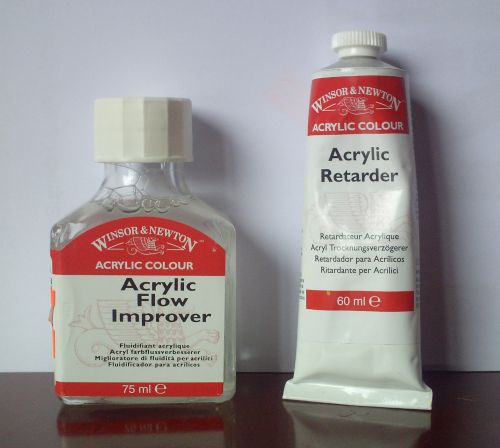|
Painting With Acrylics.
Painting With Acrylics is the number one choice for many artists. Acrylics are relatively inexpensive, they dry very quickly giving us the opportunity to add opaque layers or glazes over earlier layers in far less time than oil paints. They can be thinned to give similar results to watercolours or used like oil paints, even textured to produce an impasto effect. They can be thinned with water and used with inexpensive synthetic brushes. The paint washes off with soap and water. There is hardly any odour to them which is great if you paint at home. I initially found acrylics a little difficult to get the hang of because of their amazingly quick drying time. My natural pace is slow. Really slow. I get around this by using a retarder to help slow down drying. Even the small delay gives me time to make decisions. Using flow improver also helps. I use them in acrylic landscape painting technique and I have a tutorial on acrylic portrait painting. Have a look at the bottom of the page for more tutorials. A solid course on acrylics, particularly if you are interested in portraits and landscapes, can improve your results dramatically. For my recommendation. These are the flow improver and retarder I use when Painting with Acrylics.

Colours I also use a much larger range of colours when Painting with Acrylics than I do with oils. This saves me much time on mixing. More often than not I use the paint straight from the tube, only deciding the consistency and amount of paint I need. I see a deep green in my subject and therefore choose an approximate colour from my collection. I may add a different colour to it and allow the colours to mix on the painting surface or glaze over a dry colour but I rarely ever mix colours by hand. To my mind this would defeat the object of using acrylics in the first place. Other artists would disagree with this. I've used Winsor and Newton paints but I also have a range of Rowney Cryla paints. They are of fine quality and there is little difference between the ranges in terms of ease of handling. Winsor And Newton acrylics, however, dry with no discernible difference in colour. Dry or wet they look the same. The colours I use are: Potter’s Pink, Titanium White, Ivory Black, Yellow Ochre, Lemon Yellow, Cadmium Lemon, Pyrrole Orange, Cobalt Blue Deep, Cerulean Blue, Cobalt Green, Chromium Oxide Green, Cadmium Red Deep, Azo Yellow Medium, Ultramarine Blue, Ultramarine Violet, Olive Green, Cobalt Turquoise Light, Permanent Sap Green, Hooker’s Green, Quinacridone Gold, Raw Umber, Burnt Umber, Payne’s Gray, Graphite Grey, Permanent Alizarin Crimson. Brushes Natural hair brushes work well with acrylics but tend to take longer to spring back into shape than synthetic brushes. I use synthetic Galeria. My entire collection of Galeria brushes are rounds 1 and 4, flats 2,4,12,18,28 and filberts 2,4,12,18. Mediums, Primers and Varnishes. If you are serious about acrylics there are a number of mediums, primers, modelling paste (to help create textured paintings) and varnishes. Varnishes are essential if you intend to hang or sell your work. They form a protective layer over the paints surface. Your supplier will be able to advise on this. Personally I use Winsor and Newton mediums when designing greeting cards because there is no noticeable change in colour strength. I tend to use water to dilute my paints when either practicing or using acrylics to prepare studies for oil paintings. Please be aware that using water can have a detrimental effect on the finished look of your painting. Something you will want to avoid if selling your work. Winsor and Newton also make very good varnishes. Matt, gloss and satin. Plus a varnish remover. Here's another tutorial on Cat Painting with acrylics.
Return Home from Painting with Acrylics
|





